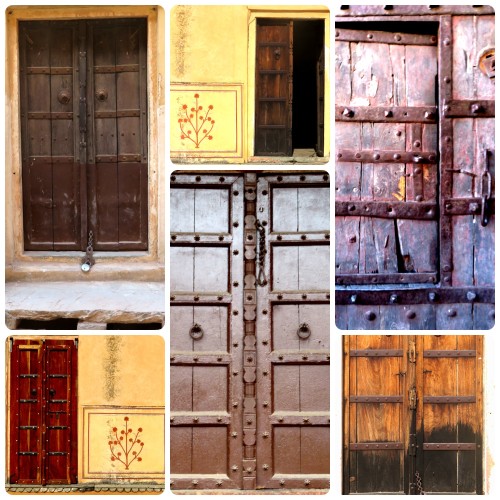Have Bag, Will Travel

Blog Stats
- 1,211,772 hits
Top Posts
-
Recent Posts
- Passage Through India – Homeward Bound and Top Ten (Part Three)
- Passage through India – Homeward Bound and Top Ten Highlights (Part Two)
- Passage through India – Homeward Bound and Top Ten Highlights (Part One)
- Passage through India – Shimla in the Himalayas
- Passage through India – “All India” Cricket
Flag Counter
Search my Site
-
Join 6,919 other subscribers
Social
Tag Archives: Rajasthan
ImagePassage through India – The Amber Fort at Jaipur
“Jaipur is a blushing bride draped in pink, dancing in our dreams while the peacocks sing.” – Vinita Kinra
There was a later start today and we were glad of that so after a leisurely breakfast (avoiding the curry of course) we transferred to the coach and headed towards Jaipur and beyond that to the Amber Fort, one of five hilltop forts in Rajasthan that are included together in a UNESCO World Heritage Site listing.
The route took us out of the city and as we climbed the city haze dispersed and the air became fresher, clearer, blue skies at last. Eventually as the road narrowed and climbed higher the bus could proceed no further so stopped in a transfer lay-by busy with urgent street vendors.
The looky-looky men were persistent and a nuisance but we were becoming accustomed to that and how to deal with them. At first it seemed rude to ignore them but this was important to do so because to make eye contact and interact was a bad mistake as this was quickly interpreted as maybe some interest in the wares (mostly tat) and they become especially difficult to shake off, best to say NO very firmly, look straight ahead, give no encouragement at all and move swiftly on.
The Amber Fort and Maota Lake where there were warning signs not to go into the water due to the presence of alligators. A decision to be made then, paddle with alligators or run the gauntlet of the street vendors.
As we waited for transport to arrive to take us to the fort a line of decorated elephants passed by each one transporting a handful of visitors in howdahs which are a sort of wooden saddle attached to the animals back. Some welfare groups are critical about this elephant ride entertainment and call for it to be stopped on welfare grounds. Many tour companies agree and don’t use the elephants but motor jeeps instead as an alternative.
I am not sure that I agree with the use of animals in this way so wasn’t disappointed but I have to say that it looks a whole lot more interesting than the donkey rides on Cleethorpes beach and I have to say that the elephants looked happier too.
The streets of the village are narrow and have no pavements, shops and stalls spill out onto the street and cows amble slowly past. Pedestrians appear curiously unaware of the danger. Surely more than enough obstructions to demand careful driving, but no, not a bit of it and the jeeps proceeded at reckless speed as though competitors in an obstacle rally towards the top of the hill. “I am a very good driver, I am a very good driver” the man behind the wheel kept repeating as though to reassure us or maybe himself and to be fair he did get us to the top without incident even without for most of the journey not keeping his eyes on the road ahead.
Stepping through the gates of the Amber Fort was truly memorable, the marble stone shimmered and dazzled in the sunlight. Apparently it was once even more beautiful, once adorned with art and precious stones but another Mughal Prince even more important than the owner of this place was rather concerned that it was even more splendid than his own Palace so ordered that the decoration be painted over and so it became Amber.
The Mughals were filthy rich, fabulously wealthy and extravagant so they indulged themselves in places like this. Their wealth was based on control of the spice route running north to Persia and beyond and by control of the local population and a punitive tax system.
The tour guide Rahi, escorted us through the courtyards and the interiors and the private royal apartments where the Mughal Prince had an arrangement of twelve fabulous rooms, one for each of his wives and that made we question if they were that clever after all.
Twelve wives is complete madness. Anyone having twelve wives must require urgent medical attention.
It also wasn’t so clever to have so many children because jealousy and bickering inevitably led to family feuds, fighting, deposition, house arrest and long term imprisonment and it was all this that contributed to the eventual fall of the Mughal Empire in India.
Most of us would happily have stayed longer at the Amber Fort but after an hour or so the visit was over, we were through the exit, pestered again by persistent vendors who rather good-naturedly take rejection without offence and back to the jeeps. If the ride up to the fort was frightening, the gravity defying return journey was terrifying. In the back we were tossed around as though in a spin dryer set to maximum speed and above the roar of the engine and the (occasional) squeal of brakes all I could hear was “I am a very good driver, I am a very good driver”.
At the transfer lay-by we were reunited with the coach and the driver Mr D P Sharma who was indeed a really good driver who took no chances and he returned us safely to Jaipur.
Posted in Asia, Cathedrals, Food, History, Natural Environment, Travel, World Heritage
Tagged Amber Fort, Elephant Ride, Jaipur, Jeep Safari, Mughul Empire, Rajasthan, UNESCO India, World Heritage India. Postcards






